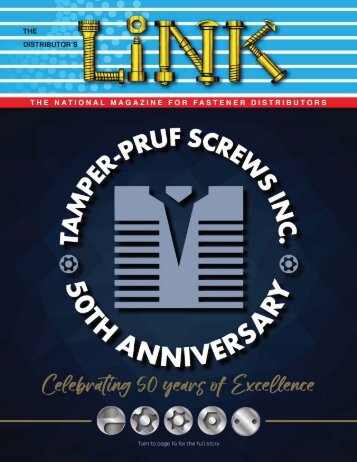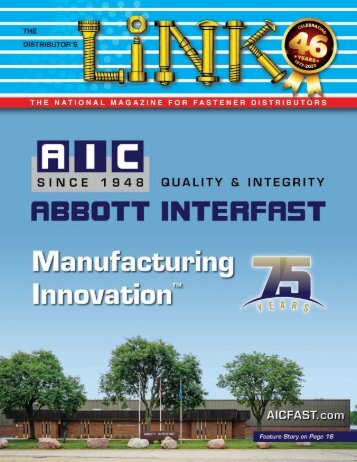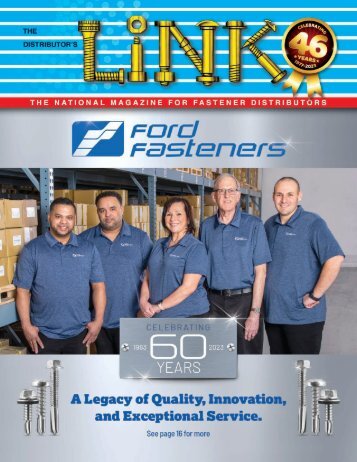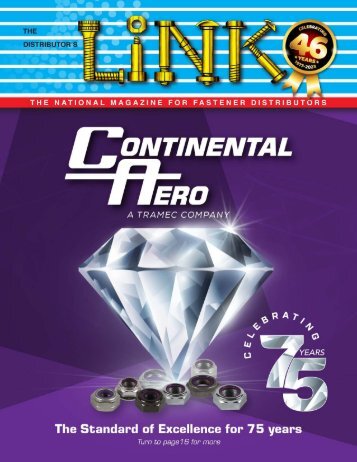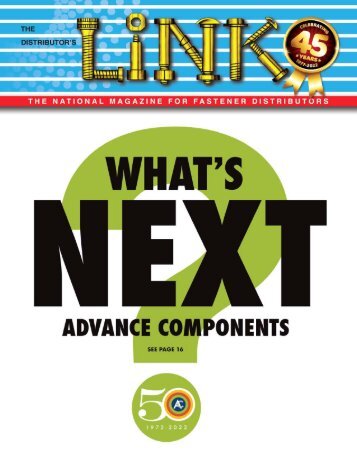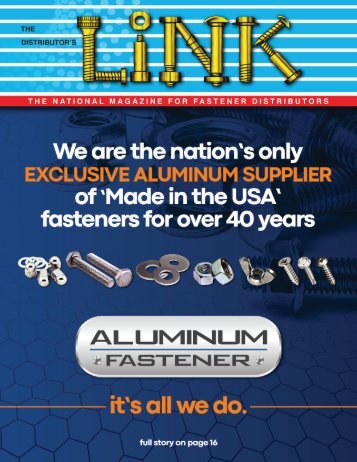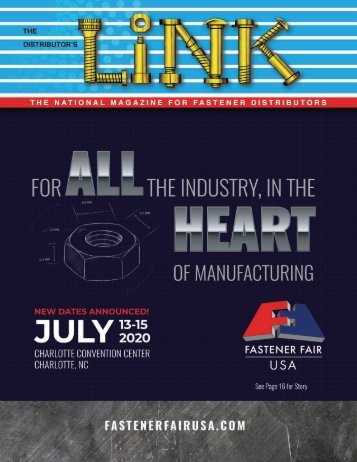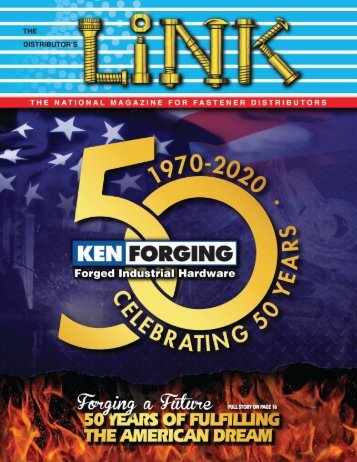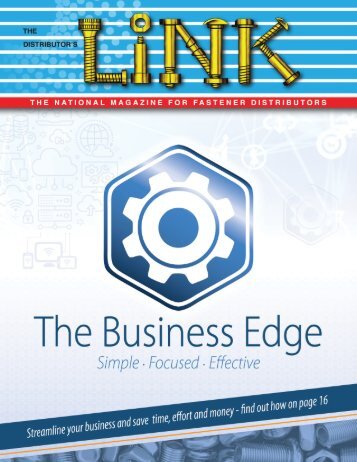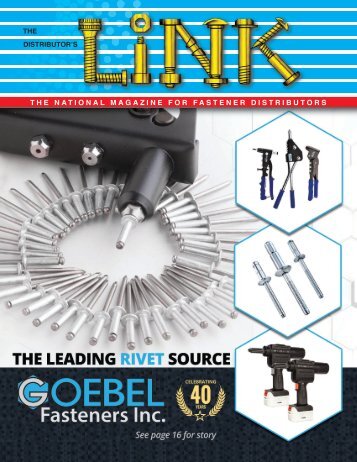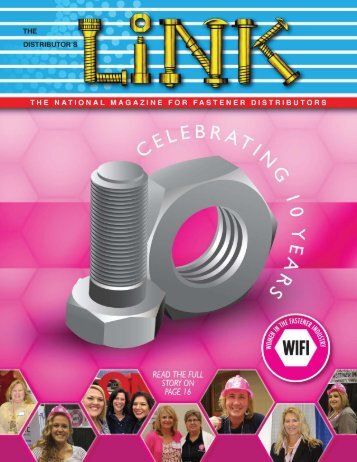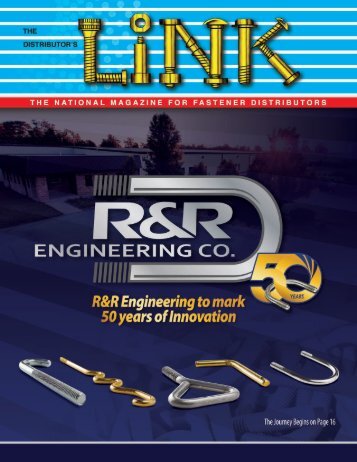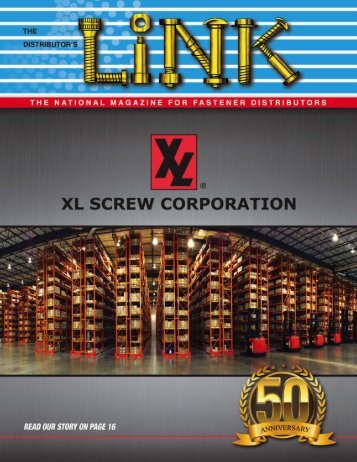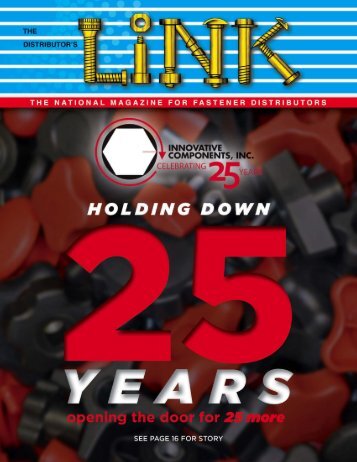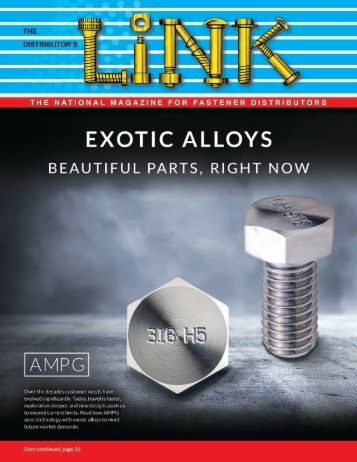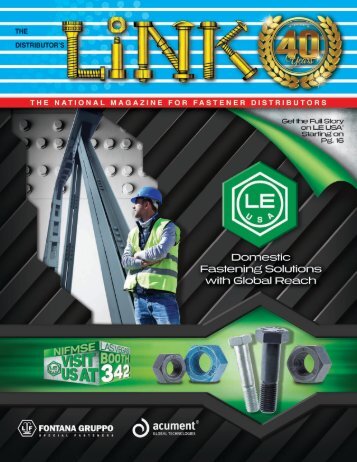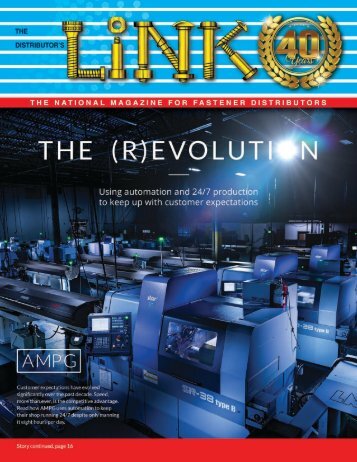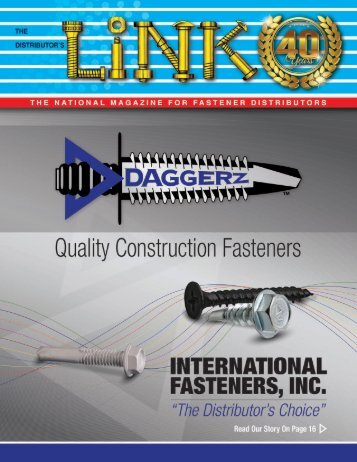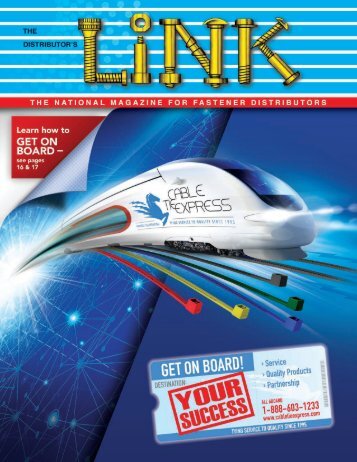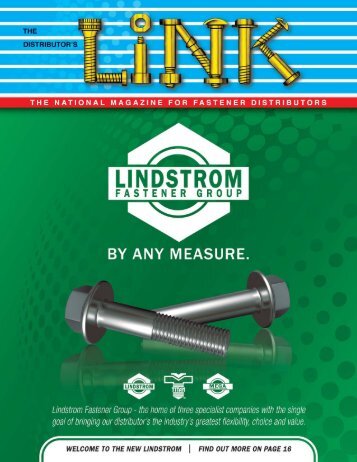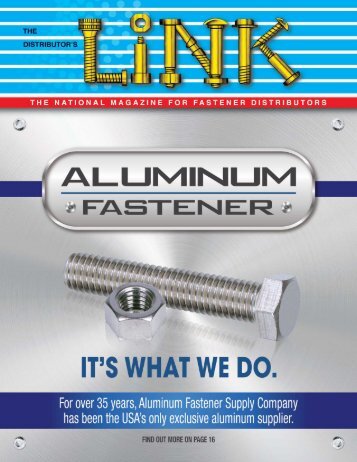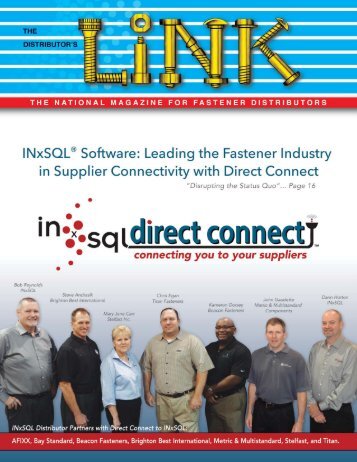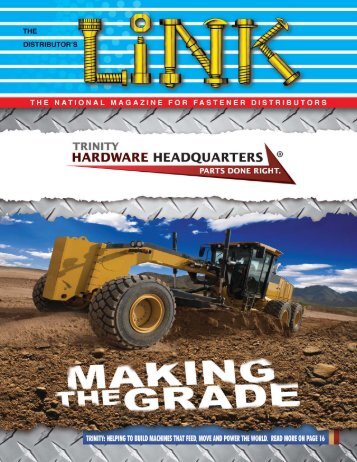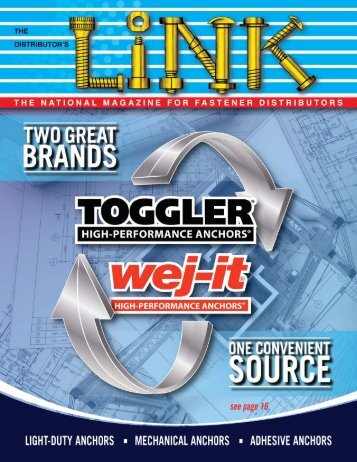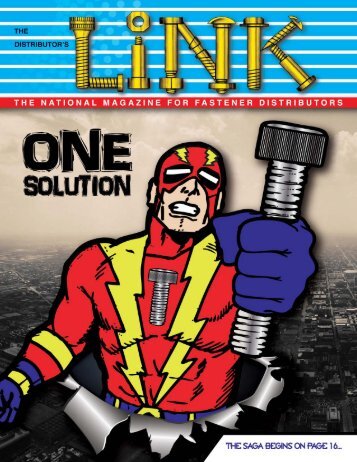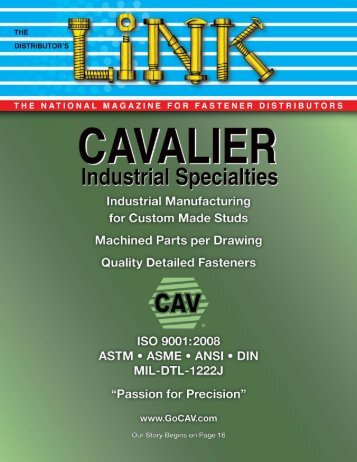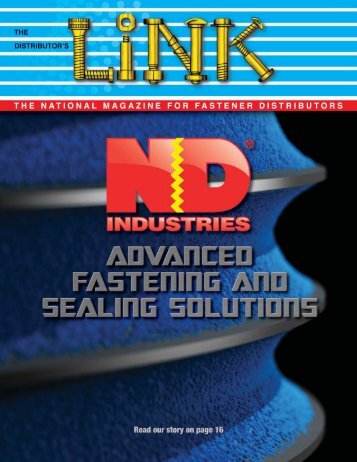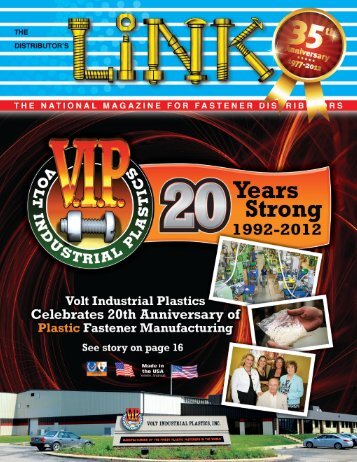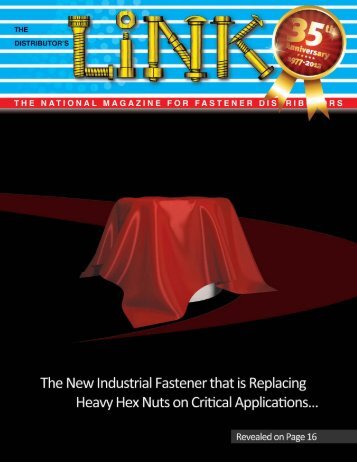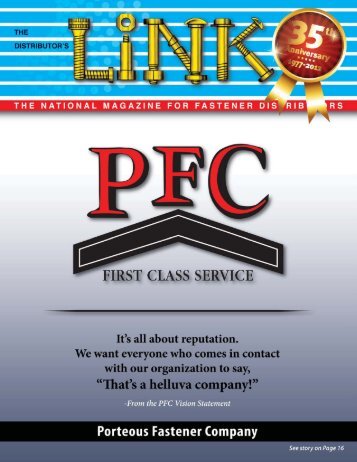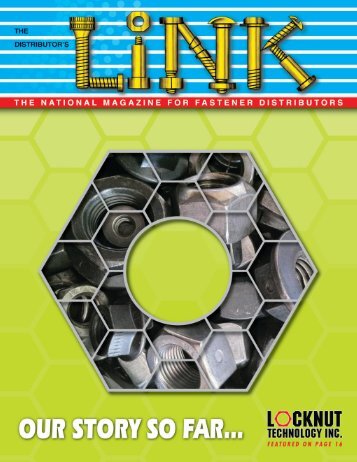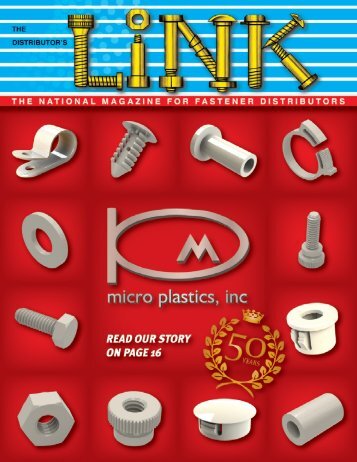SUMMER 2018
- Text
- Fastener
- Fasteners
- Products
- Diameter
- Pins
- Distributors
- Manufacturing
- Industrial
- Rivet
- Screws
174 THE DISTRIBUTOR’S
174 THE DISTRIBUTOR’S LINK SPIROL COLD HEADED VS MACHINED SOLID PINS from page 144 The purpose of a chamfer is to allow for ease of assembly. A chamfer angle between 25° – 40° is suitable for the vast majority of Solid Pin applications and allows for maximum pin engagement. From a manufacturing standpoint, the optimal cutting angle (machining) is 45°, while the optimal forming angle (cold heading) is 30° or less. EXAMPLES OF COMMON MATERIALS Material Cold Heading Machining Austenitic (nickel) stainless steel Martensitic (chrome) stainless steel Low carbon steel Alloy steel Aluminum Excellent corrosion resistance Corrosion resistant High shear strength High hardness Versatile Low cost High shear strength High hardness Corrosion resistant Lightweight Lead free 305, 302 HQ 303 410 420 1022 12L14 6150, 4037 4150 5056 2024, 6061 TABLE 3 NOTE: THIS LIST CONTAINS SOME OF THE COMMON AVAILABLE MATERIALS (OTHERS ARE AVAILABLE) Material The most common materials for Solid Pins are carbon and stainless steels. Raw materials are available in different forms depending on whether pins will be machined (rod) or cold headed (wire). Commercially available material grades for rod and wire can differ. Rod is available in material grades best suited for machining, while wire is available in material grades suited for cold heading. Although material grades may differ, the important take away is that there are equivalent materials available for headed and machined Solid Pins. Hence, best engineering practices dictate that material specifications on drawings be relatively general if possible (i.e. carbon steel with hardness rating RC 27-33). Table 3 shows examples of several common materials for cold heading and machining for reference. Cost Comparison - Cold Headed vs Machining Machined Solid Pins are typically about ten times the cost of cold headed Solid Pins. Why are cold headed Solid Pins so much more cost effective? COST OF RAW MATERIAL ($/LB) ¤ Cold heading produces Solid Pins at a rate of about 300 parts per minute (ppm), while machining yields approximately 4 ppm. ¤ Machining generates scrap. Hence, more raw material is needed to machine a Solid Pin than to cold head the same part. The only scrap generated during cold heading is that which is produced during set up. ¤ Ground OD rod can cost more than three times as much as standard rod used for machining. PIN DIAMETER TOLERANCE VS RAW MATERIAL COSTS Ground OD Rod (Machining) Standard Rod (Machining) 0 0.0002 0.0004 0.0006 0.0008 0.001 0.0012 0.0014 0.0016 0.0018 0.002 TOTAL PIN DIAMETER TOLERANCE (INCHES) GRAPH 1 Wire (Cold Heading) CONTINUED ON PAGE 184
MAFDA GOLF & SCHOLARSHIP OUTING APPLECROSS COUNTRY CLUB, DOWNINGTOWN, PA
- Page 6 and 7:
in thesummer 2018 issue of 6 DISTRI
- Page 8:
6 THE DISTRIBUTOR’S LINK Goebel F
- Page 12:
10 THE DISTRIBUTOR’S LINK Guy Ave
- Page 16:
14 THE DISTRIBUTOR’S LINK Robert
- Page 28:
26 THE DISTRIBUTOR’S LINK Jim Tru
- Page 32:
30 THE DISTRIBUTOR’S LINK Carmen
- Page 37 and 38:
THE DISTRIBUTOR’S LINK 35
- Page 40 and 41:
38 THE DISTRIBUTOR’S LINK Jim Rue
- Page 42:
40 THE DISTRIBUTOR’S LINK INDUSTR
- Page 45 and 46:
THE DISTRIBUTOR’S LINK 43
- Page 47 and 48:
THE DISTRIBUTOR’S LINK 45 Advance
- Page 50:
48 THE DISTRIBUTOR’S LINK ARNOLD
- Page 53 and 54:
INTERNATIONAL FASTENERS, INC. Tampa
- Page 55 and 56:
American Ring, a family owned and o
- Page 57 and 58:
THE DISTRIBUTOR’S LINK 55
- Page 60 and 61:
58 THE DISTRIBUTOR’S LINK GLOBALF
- Page 62 and 63:
60 THE DISTRIBUTOR’S LINK SPIROL
- Page 64:
62 THE DISTRIBUTOR’S LINK ASPHALT
- Page 68:
66 THE DISTRIBUTOR’S LINK UNIVERS
- Page 72 and 73:
70 THE DISTRIBUTOR’S LINK GLOBALF
- Page 74:
FASTENER FAIR USA WELCOME PARTY, RO
- Page 77 and 78:
THE DISTRIBUTOR’S LINK 75
- Page 79 and 80:
THE DISTRIBUTOR’S LINK 77 UNICORP
- Page 82 and 83:
80 THE DISTRIBUTOR’S LINK Roman B
- Page 84 and 85:
82 THE DISTRIBUTOR’S LINK NATIONA
- Page 86 and 87:
84 THE DISTRIBUTOR’S LINK The New
- Page 88 and 89:
86 THE DISTRIBUTOR’S LINK Bryce A
- Page 90 and 91:
88 THE DISTRIBUTOR’S LINK The Met
- Page 92:
90 THE DISTRIBUTOR’S LINK Larry B
- Page 95 and 96:
NCFA 10th ANNUAL DISTRIBUTOR SOCIAL
- Page 98 and 99:
96 THE DISTRIBUTOR’S LINK GUY AVE
- Page 100 and 101:
98 THE DISTRIBUTOR’S LINK JOE DYS
- Page 102 and 103:
100 THE DISTRIBUTOR’S LINK ROBERT
- Page 104 and 105:
102 THE DISTRIBUTOR’S LINK LAUREN
- Page 106 and 107:
104 THE DISTRIBUTOR’S LINK SOUTHE
- Page 108:
106 THE DISTRIBUTOR’S LINK MSC IN
- Page 111 and 112:
THE DISTRIBUTOR’S LINK 109
- Page 113 and 114:
FASTENER FAIR USA CLEVELAND, OH - A
- Page 115 and 116:
Lindstrom LLC, a master distributor
- Page 118 and 119:
116 THE DISTRIBUTOR’S LINK JIM RU
- Page 120 and 121:
118 THE DISTRIBUTOR’S LINK IFI 20
- Page 122 and 123:
120 THE DISTRIBUTOR’S LINK FASTEN
- Page 124:
122 THE DISTRIBUTOR’S LINK ARNOLD
- Page 127 and 128: Suncor Stainless is looking towards
- Page 129 and 130: fastenerlinks BRINGING YOU THE FAST
- Page 131 and 132: fastenerlinks BRINGING YOU THE FAST
- Page 133: THE DISTRIBUTOR’S LINK 131 Endrie
- Page 136: 134 THE DISTRIBUTOR’S LINK STAFDA
- Page 140 and 141: 138 THE DISTRIBUTOR’S LINK PACIFI
- Page 142 and 143: 140 THE DISTRIBUTOR’S LINK UNICHE
- Page 144 and 145: 142 THE DISTRIBUTOR’S LINK GLOBAL
- Page 146: 144 THE DISTRIBUTOR’S LINK SPIROL
- Page 149 and 150: FASTENER FAIR USA CLEVELAND, OH - A
- Page 151 and 152: SFA SPING CONFERENCE & GOLF OUTING
- Page 153 and 154: THE DISTRIBUTOR’S LINK 151
- Page 156: 154 THE DISTRIBUTOR’S LINK BENGT
- Page 159 and 160: FASTENER FAIR USA CLEVELAND, OH - A
- Page 161 and 162: THE DISTRIBUTOR’S LINK 159 Distri
- Page 163 and 164: THE DISTRIBUTOR’S LINK 161
- Page 165 and 166: THE DISTRIBUTOR’S LINK 163 MAFDA
- Page 167 and 168: THE DISTRIBUTOR’S LINK 165 PUZZLE
- Page 170 and 171: 168 THE DISTRIBUTOR’S LINK CARMEN
- Page 172 and 173: 170 THE DISTRIBUTOR’S LINK COMPUT
- Page 174 and 175: 172 THE DISTRIBUTOR’S LINK MICHAE
- Page 178 and 179: 176 THE DISTRIBUTOR’S LINK LARRY
- Page 180 and 181: 178 THE DISTRIBUTOR’S LINK LAUREN
- Page 182 and 183: 180 THE DISTRIBUTOR’S LINK SEFA S
- Page 184: 182 THE DISTRIBUTOR’S LINK MICHAE
- Page 188 and 189: 186 THE DISTRIBUTOR’S LINK MICHAE
- Page 190 and 191: NFDA 50th ANNIVERSARY MEETING & CEL
- Page 192 and 193: PAC-WEST 50TH ANNIVERSARY MEETING &
- Page 194: PAC-WEST 50TH ANNIVERSARY MEETING &
- Page 198: advertisers index D DELTA SECONDARY
- Page 202: advertisers index R RAF ELECTRONIC
Inappropriate
Loading...
Mail this publication
Loading...
Embed
Loading...
|
SHARE A PAGE FROM THIS MAGAZINE OPTION 1: Click on the share tab above, or OPTION 2: Click on the icon (far right of toolbar) and then click on the icon (far right of toolbar) and then click on the  icon (top right of the page). icon (top right of the page).
|
View Archives
Copyright © Distributor's Link, Inc. All Rights Reserved | Privacy Policy







